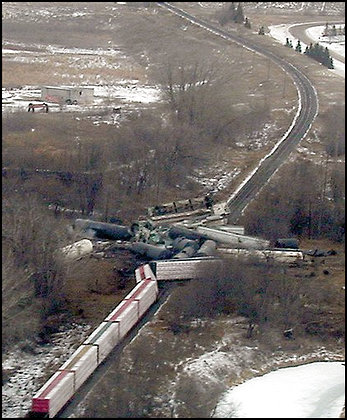
18 October 2005
Lawsuits on N.D. Derailment to Hit Courts
| |

A train derailed early Friday 18 Jan 2002 about a
mile west of Minot, N.D. sending a cloud of anhydrous ammonia over the city, killing one man, sending part
of a rail car slamming into a house and forcing dozens of people to the hospital with breathing problems.
This view is looking east with Minot's city limits starting around the bend.
|
Bismark North Dakota - For Tom Lundeen and his family, the deadly white mist that enveloped
much of their city nearly four years ago has in a sense never really dissipated.
The cloud of farm fertilizer unleashed by a train derailment forced the family from their home on the outskirts of Minot for 11 weeks
and left them with chronic lung and eye problems, Lundeen said.
The Lundeens are among 11,600 people the National Transportation Safety Board says were affected by the toxic plume that erupted
18 Jan 2002, and among hundreds who have filed lawsuits against Canadian Pacific Railway.
"It's not the same as it was prior to the derailment, and it never will be," Lundeen said. "Everybody has just kind of
gotten on with their lives, but they're looking forward to hopefully getting their cases settled here sooner than later. It's been too
long already."
The first jury trial in the case, scheduled to begin this week, could lay the groundwork for how other lawsuits, including Lundeen's,
are decided. Railroad officials have declined to talk about pending court action.
Most residents of Minot, in north-central North Dakota, were asleep when a 112-car Canadian Pacific train
derailed near Lundeen's subdivision. Five cars broke open, spewing 146,700 gallons of liquid anhydrous ammonia that turned into gas
after coming in contact with the air.
The chemical cloud quickly spread over southern Minot, burning the eyes, noses, mouths and lungs of residents - even burning trees. A
deputy trapped in the cloud for 45 minutes said it was like breathing in fire.
One man, John Grabinger, 38, died, and hundreds of people were injured, 11 seriously. Some residents had to leave their homes for
nearly three months while cleanup crews removed about 97,000 tons of contaminated soil and 25,000 square feet of river ice.
The NTSB concluded that the derailment was caused by inadequate track maintenance and inspections, a finding the railroad disputed.
Individual lawsuits against the railroad have been filed in state court in Minnesota, where the Calgary, Alberta-based
railroad has its U.S. headquarters. Court officials said Judge Tony Leung was presiding over 160 of them.
The trial set for this week in Minneapolis involved a wrongful death lawsuit filed by Grabinger's widow and another lawsuit filed by
Warren Howell, who also lived near the derailment site.
As potential jurors were filling out questionnaires Monday, lawyers told Leung that a confidential settlement had been reached in the
Grabinger case. Three other cases involving another family were settled last week; the terms were not disclosed. Jury selection in
the Howell case was scheduled for Wednesday.
In a separate federal court action in North Dakota, Fargo attorney Mike Miller represents nearly 1,000 people. U.S. District Judge Dan
Hovland in Bismarck has granted that case class action status, though the number of people who might be included has not yet been
determined.
Neither Miller nor Gordon Rudd, an attorney in Minneapolis working on some of the individual lawsuits, would say how much their
clients will seek. Lundeen declined to say what numbers he has discussed with his attorney.
The plaintiffs shouldn't assume jurors will be sympathetic, said Calvin Fayard, a Denham Springs, La., attorney who has been involved
in about a dozen lawsuits against railroads.
"I've been in cases where the train has wrecked right down the road from the courthouse, and the jurors are extremely conservative
even to the extent that they favor the industry or the railroad," he said.
Fayard said cases like that of the Minot derailment, where there are hundreds of plaintiffs, generally end in settlements.
"A lot of times, cases settle at the steps to the courthouse," Miller said. "We're at the top of the steps right
now."
|